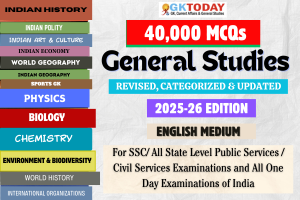Environment, Ecology & Biodiversity Multiple choice questions for GK paper in SSC, NDA, CDS, UPSC, UPPSC and State PSC Examinations.
11. Which among the following National Park in India is also called the last house of White winged Wood Duck?
[A] Salim Ali National Park , Jammu & Kashmi
[B] Nameri National Park , Assam
[C] Ghana National Park, Rajastha
[D] Sultanpur Bird Sanctuary, Haryana
Show Answer
Correct Answer: B [Nameri National Park , Assam]
Notes:
Nameri National Park is located in the Sonitpur District of Assam. It was declared as Tiger Reserve in the year 1999-2000 and became a sanctuary in 1985.
12. Which among the following National Park is distinct in India because it encompasses a Project Tiger Reserve, an Elephant Reserve and a Biosphere Reserve (all of them)?
[A] Manas Tiger Reserve
[B] Kanha Tiger Reserve
[C] Panna Tiger Reserve
[D] Simplipal Tiger Reserve
Show Answer
Correct Answer: A [Manas Tiger Reserve]
Notes:
Manas National Park is located in the state of Assam. It is a national park, UNESCO Natural World Heritage site, a Project Tiger reserve, an elephant reserve and a biosphere reserve. It is home to endangered endemic wildlife like Assam roofed turtle, hispid hare, golden langur and pygmy hog.
13. Bhadra Wildlife Sanctuary is the only Elephant Reserve of which of the following states?
[A] Chhattisgarh
[B] Karnataka
[C] Madhya Pradesh
[D] Gujarat
Show Answer
Correct Answer: B [Karnataka]
Notes:
Bhadra Wildlife Santuary is situated inthe state of Karnataka (Chikamagaluru district). It was formerly known as Jagara Valley Wildlife Sanctuary’ in 1951. In 1974, it was renamed as Bhadra Wildlife Santuary.
14. Headquarters of Biodiversity International are located at?
[A] Rome
[B] Geneva
[C] Paris
[D] Manila
Show Answer
Correct Answer: A [Rome]
Notes:
Bioversity International, a non-profit research organization for development, was established in 1974. The motto of the organization is “Agricultural biodiversity nourishes and sustains the planet”. It is headquatered at Rome, Italy.
15. The Hydroponics is most closely related to which among the following?
[A] Grafting of Plants
[B] Water conservation
[C] Study of Vegetable
[D] Soilless culture of Plants
Show Answer
Correct Answer: D [Soilless culture of Plants]
Notes:
Hydroponics is a type of Horticulture and a subset of hydroculture, through which plants are grown without soil, by providing mineral nutrient solutions in a water solvent.
16. ‘Lion-tailed macaque’ is the key faunal species of which Biosphere Reserve?
[A] Nilgiri
[B] Dehang-Debang
[C] Dibru-Saikhowa
[D] Nokrek
Show Answer
Correct Answer: A [Nilgiri]
Notes:
Silent Valley National Park is located in the state of Kerala and is located in the Nilgiri hills. It is home to the lion-tailed macaques, an endangered species of primate. In 1973, “Save Silent Valley” campaign (environmental movement) was initiated when the Kerala State Electricity Board declared to implement the Silent Valley Hydro-Electric Project.
17. Which among the following terms of utmost significance in the dynamics of resource management was coined in the ‘Brundtland Commission Report’?
[A] Polluter-Pays Principle
[B] Sustainable development
[C] Inclusive Growth
[D] Carrying Capacity
Show Answer
Correct Answer: B [Sustainable development ]
Notes:
Brundtland Commission was named after Gro Harlem Brundtland, the former Prime Minister of Norway. This commission, formally known as World Commission on Environment and Development (WCED) was established by UN in 1983. It had released its report called Brundtland Report in 1987. This report popularized the term Sustainable Development.
18. The rate of water erosion can increase if there is :
[A] a decrease in precipitation
[B] an increase in rock particle size
[C] an increase in vegetative cover
[D] an increase in livestock grazing
Show Answer
Correct Answer: D [ an increase in livestock grazing]
Notes:
Negative effects of grazing (or more usually over-grazing) include increased soil erosion, adverse water quality impacts from increased runoff and loss of biodiversity.
19. In recent times, the “Biological passport” has been of immense use in ___:
[A] Diagnosis of fatal diseases at a very early stage
[B] Understanding the evolution of various organisms
[C] Determine the complete genome sequence of an organism
[D] Eliminating doping in sports
Show Answer
Correct Answer: D [ Eliminating doping in sports]
Notes:
“Biological passport” has been of immense use in the field of sports, particularly in the context of anti-doping efforts and maintaining fair competition. The Biological Passport is a sophisticated and comprehensive monitoring system that tracks the physiological parameters and biomarkers of athletes over time. It is primarily used in sports to detect and deter the use of performance-enhancing drugs and doping practices.
20. With reference to the fauna of India, what is Southern Birdwing?
[A] Sparrow
[B] Lizard
[C] Butterfly
[D] Mormon
Show Answer
Correct Answer: C [Butterfly]
Notes:
The Southern Birdwing is a large and striking Swallowtail butterfly endemic to Peninsular India. With a wingspan of 140–190 mm, it is the largest butterfly found in southern India. You may note that Grass Jewel is the smallest butterfly of India and Atlas Moth is the largest moth found in India.
 These questions are part of GKToday's 40,000+ GK Questions Course in GKToday Android Application which provides more than 40K questions with explanations suitable for all Competitive Exams of India.
These questions are part of GKToday's 40,000+ GK Questions Course in GKToday Android Application which provides more than 40K questions with explanations suitable for all Competitive Exams of India.
